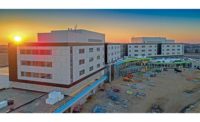"The prebid mock-up process brought us together as a team to jointly prequalify the largest casework/millwork subcontractors," Fedorchak says. "Through this process, we were able to communicate the complexity of the package to the potential bidders and define the level of quality we expected out of the lowest responsive bidder. The process leveled the playing field."
As a result, the $8-million contract went to Phoenix-based Western Millwork, which evaluators say demonstrated superior ability to work at the required standards.
A Very Big Room
The project team sees the jobsite trailer as reflecting the IPD process by fostering collaboration, equal representation and no-silos decision-making. It's one of the largest centralized temporary construction offices ever used in California—"a job trailer on steroids."
Throughout the project, Kitchell staff, design engineers and CannonDesign architects are co-located in adjacent studios, along with design-assist shoring, steel, MPE and other subcontractors.
A building information modeling room with workstations and a conference area accommodates design specialists from all parties. By including subcontractors in the design phase, the collaborative process—from design intent to fabrication drawings and implementation —has also produced savings for the Kitchell team. "'Draw it once' has been our mantra," Wolfe says.
The Big Room layout is defined by activities, not by disciplines. "Because [project team] representatives are all working shoulder to shoulder at the outset, the design is embedded within each stakeholder," Wolfe says.
The process has been helpful for detecting clashes before construction activity in the field so that problems are resolved expeditiously. Regular meetings ensure that schedules are met.
"Each key team member brings a specific skill set to facilitate discussions within each studio to connect designer and trade partners to produce a comprehensive BIM model with zero redundancy," Wolfe says.
Alan Gunnin, Kitchell's director of field operations, says the largest benefit has been the ability to gather team members and to work through issues in half the usual time. "By not working in silos, we have been able to work through several issues and hold our original schedule dates," he says.











